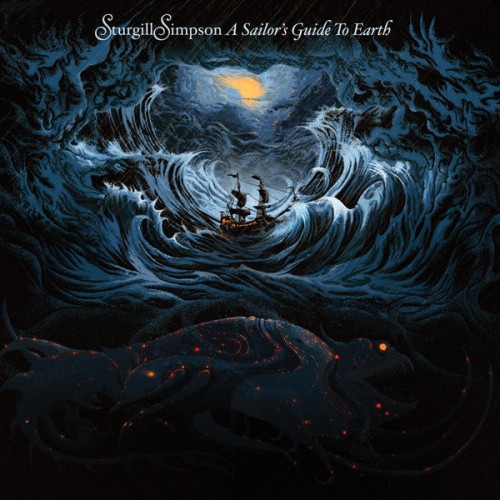Sturgill Simpson’s appearance on Mark Maron’s WTF podcast this week (listen soon; it will go behind a paywall in a week or two I think) reminded me just how much there is to unpack from his new record A Sailor’s Guide to Earth.
 |
     |
It’s a wonderful left turn of a record, released when fans and critics would have welcomed a Metamodern Sounds pt. II. Self-produced, it sounds clear, warm, and open, the Dap-Kings’ soulful horns swirling chocolate-and-peanut-butter-like with Simpson’s brand of slacker psychadelic outlaw country.
Sturgill’s been open about A Sailor’s Guide… being a song cycle written for his family, especially his first child who was born just as his career took off. What he hasn’t said – and there’s a tantalizing hint in the Maron interview about this – is just how deep the concept goes. I think the album is sequenced chronologically beginning with a father singing a song to his newborn son and continuing as the son grows up, maybe having a child of his own.
- “Welcome to Earth (Pollywog)” is sung to a newborn
- “Breakers Roar” comforts a young child
- “Keep it Between the Lines” offers advice to a teen
- “Sea Stories” finds a father and his young adult child developing a more mature relationship
- “In Bloom” (Nirvana cover)
- “Brace for Impact (Live a Little”) reminds a thirty-something child that life can be short, and it should be fun
- “All Around You” illustrates a deep connection, only able to be seen through long experience, with a child who is now old enough to have felt real pain
- “Oh Sarah” shifts the spotlight to the steady partner whose presence has been felt, but not addressed directly, throughout the record
- “Call To Arms” – The old man’s got nothing to lose and speaks his mind (not that he hasn’t always), turning from his family outward toward the world
“In Bloom” is the outlier here, thematically and musically. As it sits in the center of the sequence it strikes me as meaningful, though I’m not entirely sure what to make of it. It’s, for me, the weak point on the record musically as Simpson drops half of the chord sequence from the verse, rendering the tension of the original toothless.
Maybe changing Nirvana’s rager into a lullaby illustrates a father nostalgic for his younger child while simultaneously recognizing the adult he’s become. Or maybe I’m reaching. But the rest of the album makes so much sense – six songs of a child growing up, followed by two turning progressively outward to others – I need a way to understand the intent here.
Simpson can obviously write incisive, vivid lyrics when he wants to. That this record also features some fairly worn cliches struck me as odd at first, though they’re wearing alright with time. Sometimes the language of love and family is what’s comfortable and familiar, said a thousand times and no less true for it.
| MR|Review directs readers’ limited attention among works via ratings, and within works via prose, focusing on works where our opinion diverges from critical or popular consensus, or we have significant insight that compliments or challenges readers’ aesthetic experience. | MR|Review totals to date: | ||
| Must-hear! | 2 | ||
| Recommended | 13 | ||
| Good | 10 | ||
| Fans only | 10 | ||
| Skip this | 3 | ||
| Owww! My ears! | 0 | ||
